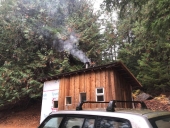I suspect my experience is fairly common. I have heard others make similar observations, at any rate.
The fire runs hot and at full speed, for the most part, and then it burns out, and shortly thereafter you close up the feed tube opening.
You listen to the stove "rocketing" and when you no longer hear it rocketing, you know it is time to rearrange the wood, and wiggle the sticks around to get it going at a "roar" again. You may or may not add more wood at this time. And at all times during the burn, you periodically move the covering fire brick over the feed tube opening to keep the bricks snuggled up to the wood, so as to reduce the size of the air gap.
If the wood burns down substantially, and you have not snugged up the brick, reducing the air gap, it may begin to smoke-back into the room. Also if wood snags and fails to fall down into the ashes, it may encourage smoke-back, or start to go out; this difficulty is reduced by feeding the sticks in big-end first, so that the smaller diameter end is sticking up. That way the bigger part burns first, and the stick tend to fall onto the coals on their own, because there is slightly more room as they all burn. However, odd pieces of bark or little stubs of old branches can still get caught up, and then you have to adjust the stick manually.
When my last stick "falls" I rake the coals into a pile, and place that small piece of wood on top of them. I then close the air gap to something like 1/2-inch or maybe as much as 1-inch. When that appears to burn all the way down, and there are only coals remaining, and not any wood pieces to burn, and no flames, I reduce that gap to something like 1/4- to 1/2-inch. Then I leave it that way until I think to check it again, usually on the order of 30- to 60-minutes. I rake the coals, seeing what I see. If the coals appear dead, I will reduce that gap almost completely.
If I am still up an hour or more later, I may check them again to verify it is only ash, and no little pieces of coal in there; if so I may close the feed tube opening as well as I can. In my case, that means putting laying down a piece of aluminum foil larger than the opening, on top of that, a couple pieces of ceramic tile I have, and on top of that I place my fire brick that I use to control the air gap while it is burning.
I have not made a P-channel, but that is something else one may wish to investigate. It gets good reviews by most who have tried it. Peterberg came up with the idea (hence, Peter-Channel, or P-Channel) That is a piece of metal that is shaped like a fat T, that is inserted into the feed tube opening, in such a way that it maintains a small gap between the wood, and the edge of the feed tube opening that is nearest the opening to the burn chamber. There are extensive forum discussions of this over at Donkey's forum (go to
http://donkey32.proboards.com/#category-1 and try searching for Peter-Channel and P-Channel; or maybe someone here can post direct links). This was also discussed in the the appendix of "the Book" by Evans, at least in the latest edition (I don't know which edition the P-Channel first appeared).





 1
1


































